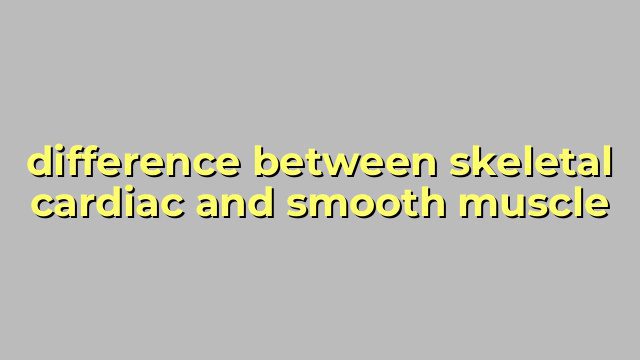The Differences Between Skeletal, Cardiac, and Smooth Muscle
Introduction
Muscles play a vital role in the human body, providing the force necessary for movement and other physiological functions. There are three types of muscle tissue, each with unique characteristics and functions. These are skeletal, cardiac, and smooth muscle.
Skeletal Muscle
Skeletal muscles are the most common type of muscle in the body, making up around 40% of total body weight. They are attached to bones by tendons and are responsible for voluntary movements, such as walking, jumping, and lifting weights.
Skeletal muscles are composed of long, cylindrical muscle fibers that are multinucleated, meaning they contain multiple nuclei. These fibers are capable of producing large amounts of force and can contract quickly. Skeletal muscles are under conscious control, which means that you can decide to contract or relax them as needed.
Cardiac Muscle
Cardiac muscles are only found in the heart and are responsible for pumping blood throughout the body. Unlike skeletal muscle, cardiac muscle is involuntary, meaning you cannot consciously control its contraction.
Cardiac muscle fibers are striated and cylindrical, like skeletal muscle, but they are shorter and branched. They contain a single nucleus, and the fibers are connected to each other by intercalated discs, which allows for coordinated contraction throughout the heart.
Smooth Muscle
Smooth muscle is found in the walls of internal organs and blood vessels, and it is responsible for involuntary movements such as digestion, urination, and blood vessel constriction. Smooth muscle fibers are tapered and lack striations, giving them a smooth appearance. They contain a single nucleus and can divide and regenerate in response to injury or damage.
Smooth muscle is not under conscious control, but it can be influenced by the autonomic nervous system and hormones. For example, the sympathetic nervous system can cause smooth muscle to contract, leading to blood vessel constriction during the “fight or flight” response.
Conclusion
In summary, skeletal, cardiac, and smooth muscle all have unique structures and functions. Skeletal muscle is responsible for voluntary movement, cardiac muscle pumps blood throughout the body, and smooth muscle controls involuntary movements. Understanding the differences between these muscle types can be useful for healthcare professionals, athletes, and anyone interested in the science of the human body.
Table difference between skeletal cardiac and smooth muscle
| Skeletal Muscle | Cardiac Muscle | Smooth Muscle | |
|---|---|---|---|
| Shape and Size of Muscle Fibers | Long and Cylindrical | Branching and Cylindrical | Short and Spindle Shaped |
| Striation | Yes | Yes | No |
| Number of Nuclei Per Fiber | Multinucleated | Uninucleated | Uninucleated |
| Location in the Body | Attached to Bones | Heart | Walls of Internal Organs |
| Control over Contraction | Voluntary | Involuntary | Involuntary |
| Contraction Speed | Fast | Moderate | Slow |
| Fatigue | Susceptible | Resistant | Resistant |
| Regulation of Contraction | Neurons and Hormones | Pacemaker Cells | Pacemaker Cells and Hormones |
